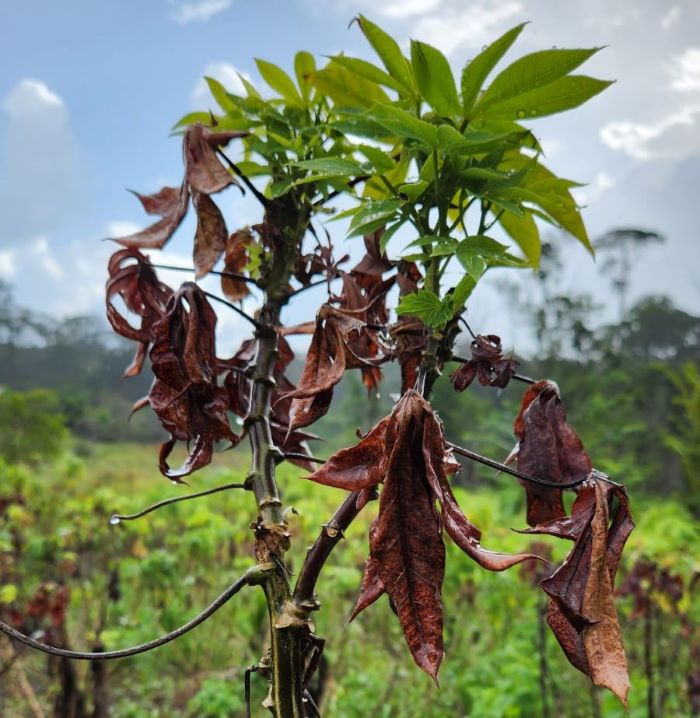Embrapa identifies first case of witches' broom in cassava in Brazil
Embrapa identifies first case of witches' broom in cassava in Brazil
Photo: Adilson Lima

The disease was found in cassava plantations in the indigenous lands of Oiapoque, on the border with French Guiana.
The disease is caused by a fungus that has been detected in the country for the first time.
Based on biological and molecular analyses, Embrapa Amapá and Embrapa Cassava and Fruits confirmed to the Brazilian Ministry of Agriculture and Livestock (MAPA) the first record of the presence of the fungus Ceratobasidium theobromae (also known as Rhizoctonia theobromae), which causes cassava witches' broom, in Brazil. The pathogen was confirmed by a MAPA report through the analysis of the identification of the species by a team in the ministry.
The disease was found in cassava plantations in the indigenous lands of Oiapoque, a town in the state of Amapá, located on the border with French Guiana. The presence of Ceratobasidium theobromae represents a risk of significant reduction in the yield of affected cassava plants. The fungus has not been detected in other hosts in Brazil so far.
"Witches' broom" is named as such because it leaves plant branches dry and deformed, with dwarfism and proliferation of weak and thin shoots from the stems, making it look like a dry broom. As the disease evolves, chlorosis, wilting and leaf drying commonly occur, and eventually apical and descending plant death.
Ceratobasidium theobromae can be dispersed through infected plant material, pruning tools, and contaminated soil and water. "Moving plants and agricultural products across regions can facilitate the spread of the pathogen, increasing the risk of infection in new areas", the Technical Note by Embrapa warns (read the full file in Portuguese here ).
Researchers from the French Agricultural Research Centre for International Development (CIRAD/France) and from the International Center for Tropical Agriculture (CIAT/Colombia) collected and isolated Ceratobasidium theobromae in affected areas with similar symptoms in the French Guiana, close to the frontier with Brazil and Suriname.
Embrapa reinforces that the detection of Ceratobasidium theobromae in Brazil requires immediate cooperation among technical assistance agents, state plant defense bodies, researchers, farmers and government authorities, as it is fundamental to implement efective containment, management and control measures to ensure agricultural production safety and sustainability. Embrapa's discovery can contribute to scientific progress in research for cassava breeding and to recommended measures to control the disease.
Recommendations to reduce impact of the disease1. Intensified monitoring and surveillance of cultivated areas for early identification of symptoms. 1.1. Early detection protocol for the pathogen via PCR and/or via HTS sequencing to support monitoring and surveillance activities. 1.2. Accreditation of labs to diagnose and index important cassava pathogens. 2. Quarantine: Implementation of quarantine measures to restrict the movement of plant material from affected areas. 3. Healthy Cuttings: Use of provenly healthy cassava cuttings, which were either produced in regions without the disease or in conditions that do not allow the pathogen to grow (e.g. thermal chambers, nurseries and greenhouses) 4. Chemical Treatment: Use of specific fungicides to control the spread of the pathogen, in compliance with local regulations. 5. Crop Practices: removal and burning of diseased plants to reduce inoculation in affected areas and decrese the incidence of new infected plants. 6. Asepsis/Sanitization of tools used to destroy plants presenting signs of the disease. A wash with water and detergent is followed by sanitization with a 1.25% sodium hypochlorite solution. 7. Bagging and promptly washing clothes, shoes and headgear worn in visits to areas affected by the disease, so as to prevent the dissemination of spores to other regions of the country. 8. Publications, videos and poster to raise awareness about signs of the disease and means of transmission. |
History for the collection of infected material
In March 2023, a team from Embrapa Amapá participated in the 29th Assembly of Indigenous Peoples and Organizations of Oiapoque for Assessment and Planning (APIO), an event held by the Council of Chiefs of Oiapoque Indigenous Peoples (CCPIO). The research institution was tasked with assessing and planning activities within its scope of attributions to mitigate the occurrence of cassava diseases. In the following week, a team identified in loco signs of cassava witches' broom in the Ahumãm, Anawerá, Tuluhi and Tukay indigenous villages.
Later on, the same signs were detected in the Kuahí, Ywawká, Karibuen, Kuai Kuai, Ariramba, Galibi, Lençol, Manga, Zacarias and Japiim villages. According to Embrapa Amapá's Technical Note, on the occasion of the detection of the first signs of the disease, infected cassava stems were transported to Embrapa Amapá's Plant Protection Laboratory to isolate the likely etiological agent in lab conditions.
Molecular analysis of the fungus
As symptoms of the disease evolved in the indigenous cassava plots in Oiapoque, new infected plant samples were analyzed at Embrapa Cassava and Fruits' Plant Pathology Lab in Bahia for the molecular diagnosis of the causal agent of the outbreak in Amapá.
The samples were then lyophilized and preserved at -80 °C for deep sequencing analysis in high-throughput sequencers in the Illumina and Nanopore platforms, in partnership with the German Collection of Microorganisms and Cell Crops (Deutsche Sammlung von Mikroorganismen und Zellkulturen - DSMZ), in Germany.
That was followed by the sequencing of pooled samples based on different tissues (leaves, stalks and stems), and the comparison with similar pathogens, including endemic ones, ones that are relevant for the crop, and others that had not been reported in Brazil.
The technique detected a large set of pathogens and endophytic organisms that are associated with the crop but which had never been reported in association with the signs observed on site, with the exception of Ceratobasidium theobromae, a fungus that had never been reported in the Americas.
Dulcivânia Freitas (DRT-PB 1.063/96)
Embrapa Amapá
Press inquiries
amapa.nco@embrapa.br
Further information on the topic
Citizen Attention Service (SAC)
www.embrapa.br/contact-us/sac/
